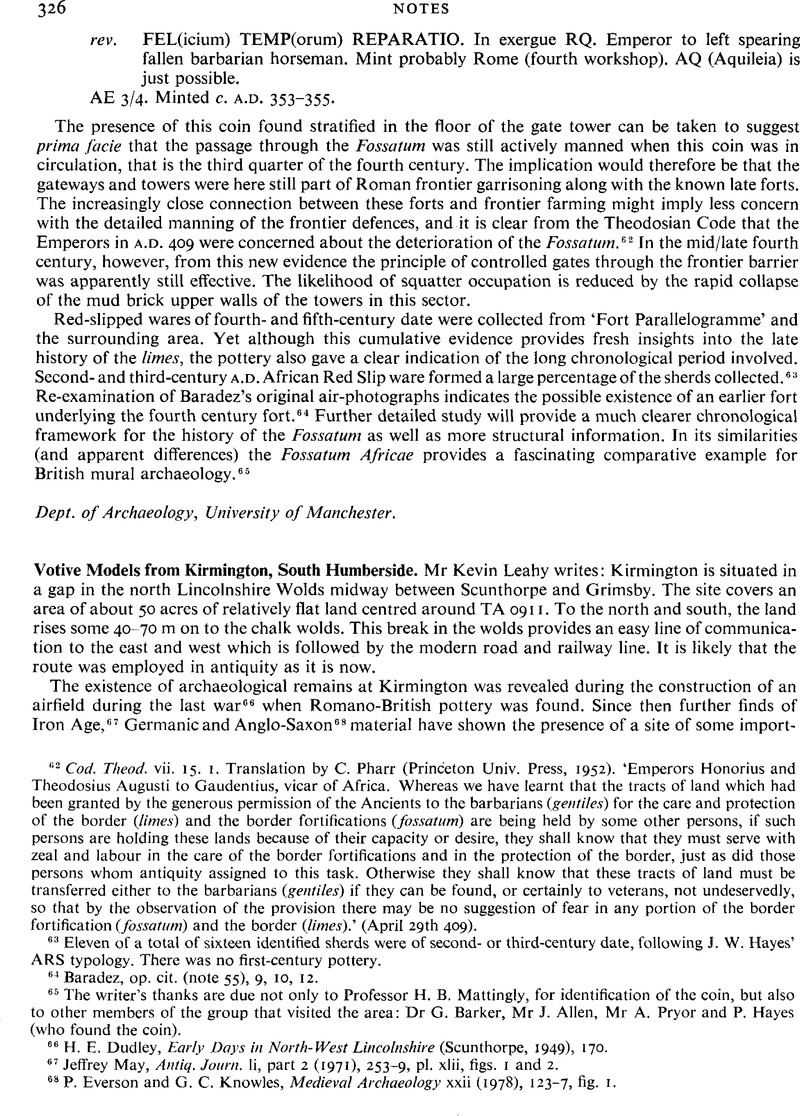Article contents
Votive Models from Kirmington, South Humberside
Published online by Cambridge University Press: 09 November 2011
Abstract

- Type
- Notes
- Information
- Copyright
- Copyright © Mr Kevin Leahy 1980. Exclusive Licence to Publish: The Society for the Promotion of Roman Studies
References
62 Cod. Theod. vii. 15. 1. Translation by C. Pharr (Princeton Univ. Press, 1952). ‘Emperors Honorius and Theodosius Augusti to Gaudentius, vicar of Africa. Whereas we have learnt that the tracts of land which had been granted by the generous permission of the Ancients to the barbarians (gentiles) for the care and protection of the border (limes) and the border fortifications (fossatum) are being held by some other persons, if such persons are holding these lands because of their capacity or desire, they shall know that they must serve with zeal and labour in the care of the border fortifications and in the protection of the border, just as did those persons whom antiquity assigned to this task. Otherwise they shall know that these tracts of land must be transferred either to the barbarians (gentiles) if they can be found, or certainly to veterans, not undeservedly, so that by the observation of the provision there may be no suggestion of fear in any portion of the border fortification (fossatum) and the border (limes).’ (April 29th 409).
63 Eleven of a total of sixteen identified sherds were of second- or third-century date, following J. W. Hayes' ARS typology. There was no first-century pottery.
64 Baradez, op. cit. (note 55), 9, 10, 12.
65 The writer's thanks are due not only to Professor H. B. Mattingly, for identification of the coin, but also to other members of the group that visited the area: Dr G. Barker, Mr J. Allen, Mr A. Pryor and P. Hayes (who found the coin).
66 Dudley, H. E., Early Days in North-West Lincolnshire (Scunthorpe, 1949), 170.Google Scholar
67 May, Jeffrey, Antiq. Journ. li, part 2 (1971), 253–9, Pl. xlii. figs. 1 and 2.CrossRefGoogle Scholar
68 Everson, P. and Knowles, G. C., Medieval Archaeology xxii (1978), 123–7, fig. 1.CrossRefGoogle Scholar
69 Riley, D. N., Britannia viii (1977), 189–92CrossRefGoogle Scholar, figs. I and 2, pl. xiv. Joseph, St., JRS lxvii (1977), 158–9, pl. xvi.2.Google Scholar
70 As a plan of the site together with its location and aerial photographs of the crop marks which appear have recently been published both in this journal and in JRS (Riley and St. Joseph, op. cit., note 69) it is felt that its repetition here is unnecessary.
71 The types of Roman military helmet are described by H. Russell-Robinson in The Armour of Imperial Rome (1975).
72 Pompeii A.D. 79 (Exhibition Catalogue, 1976), Cat. No. 304.
73 J. M. C. Toynbee, Art in Roman Britain (1968), Cat. No. 158, pl. 176–7.
74 ibid. Cat. No. 156, pl. 193.
75 ibid. Cat. No. 191, pl. 225–6.
76 Green, Miranda, Arch. Journ. cxxxii (1975), 54–77.Google Scholar Gazetteer No. 20.
77 The earlier finds of votive shields are from the temple site at Frilford, Berks., which were found with a model sword, Bradford, J. S. P. and Goodchild, R. G., Oxoniensia iv (1939), 14Google Scholar, pl. V, B. Worth, Kent, three model shields found in Iron Age features predating a Roman-British Temple, Klein, W. G., Antiq. Journ. viii (1928), No. 1, 76–81CrossRefGoogle Scholar, fig. 11 with note on the shields by Smith, R. A.. Hod Hill, Dorset, model shield now lost, found on hill fort, Antiq. Journ. ii (1928), No. 2, 97–9Google Scholar, fig. 4. Breedon on the Hill, Leics., model shield found during excavation of hill fort, Wacher, J. S., Trans. Leic. Arch. & Hist. soc. lii (1976–1977), 6–7Google Scholar, fig. 4a with a note on the shield by Ian Stead.
78 Two examples from Worth and one from Kirmington.
- 3
- Cited by


